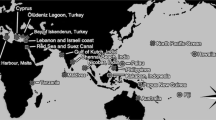Summary
Specimens ofEphydatia fluviatilis can fuse if they are compatible. Sponges only a few days old fuse completely after contact. If the young sponges have already laid down the excurrent canal system before touching one another, fusion is incomplete; if comprises only the pinacoderm, the incurrent canal system and the mesenchyme of the partner, but not the excurrent system. In principle, however, there is no difference between complete and incomplete fusion.
During the seasonal disintegration or period of gemmula formation by larger specimens, parts of the body may form small autonomous sponges capable of living for some time.
All the evidence indicates that individuals of the speciesEphydatia fluviatilis live in the form of many spatially distinct single specimens, which can fuse after accidental contact, and can also separate into autonomous specimens.
The individuality barrier between different individuals ofEphydatia fluviatilis is insurmountable and comparatively normal.
If as appears advisable, one does not equate “individual ” with “ specimen ”, then the individuality ofEphydatia fluviatilis should be regarded as extensive rather than the opposite.
Zusammenfassung
Einzelexemplare vonEphydatia fluviatilis können fusionieren, sofern diese miteinander verträglich sind. Wenige Tage alte Jungschwämme verwachsen nach der Kontaktaufnahme vollständig. Haben die jungen Schwämme ihr ausführendes Kanalsystem vor der Berührung bereits angelegt, dann bleibt die Verwachsung unvollständig, d.h., sie erfaßt nur das Pinacoderm, das einführende Kanalsystem und das Mesenchym der Partner, nicht aber das ausführende Kanalsystem. Prinzipiell unterscheidet sich die vollständige Verwachsung jedoch nicht von der unvollständigen.
Bei der jahreszeitlich oder durch Gemmulabbildung bedingten Rückbildung größerer Exemplare können autonome Teilschwämme anfallen, die noch eine Zeitlang lebensfähig sind.
Alle Anzeichen sprechen dafür, daß die Individuen der SchwammartEphydatia fluviatilis jeweils in einer Vielzahl von Einzelexemplaren in räumlicher Trennung leben, nach zufälligem Kontakt fusionieren, aber auch in autonome Exemplare zerfallen können.
Die Individualitätsschranke verschiedener Individuen vonEphydatia fluviatilis ist unüberwindbar und vergleichsweise normal.
Setzt man „Individuum“ nicht gleich „Exemplar“, was ratsam erscheint, dann ist beiEphydatia fluviatilis die Individualität nicht niedrig, sondern extensiv zu veranschlagen.
Similar content being viewed by others
Abbreviations
- A:
-
Atrium (Abb. 1 u. 2)
- A:
-
Amöbocyt (Abb. 9)
- aK:
-
ausführender Kanal
- DP:
-
Dermalpore
- E:
-
Egestionsöffnung
- eK:
-
einführender Kanal
- EnP:
-
Endopinacocyten
- ExP:
-
Exopinacocyten
- G:
-
Gemmulaschale (Abb. 1, 2, 4, 11)
- G:
-
Gemmulaanlage (Abb. 3, 7, 10)
- GK:
-
Kragengeißelkammer
- M:
-
Mesenchym
- N:
-
Nadel
- OR:
-
Oskularrohr
- PD:
-
Pinacoderm
- S:
-
Schwamm
- S:
-
Substrat (Abb. 8)
- Sp:
-
Spongin
- SR:
-
Subdermalraum
- VZ:
-
Verwachsungszone
Literatur
Ankel, W.E.: Über Fragen der Formbildung und der Zelldetermination bei Süßwasserschwämmen. Verh. Dtsch. Zool. Ges. 1948, Suppl. Bd.13, 58–66
Ankel, W.E.: Der SüßwasserschwammEphydatia fluviatilis. Zool. Anz.28, 426–444 (1965)
Ankel, W.E., Eigenbrodt, H.: Über die Wuchsform von Spongilla in sehr flachen Räumen. Zool. Anz.145, 195–204 (1950)
Brien, P.: Les éponges. Leur nature metazoaire, leur gastrulation, leur état colonial. Ann. Soc. Roy. Zool. Belg.97, 197–235 (1967)
Curtis, A.S., Van de Vyver, G.: The control of cell adhesion in a morphogenetic system. J. Embryol. exp. Morph.26, 295–312 (1971)
Delage, Y.: Sur le development des Eponges (Spongilla fluviatilis). C.R. Acad. Sc. Paris113, 267–269 (1891)
Hertwig, O.: Die Individualitätsstufen im Organismenreich. In: Allgemeine Biologie (O. Hertwig, G. Hertwig, Hrsg.) Kap. 14, S. 489–504. Jena: Gustav Fischer 1923
Höhr, D.: Differenzierungsvorgänge in der keimenden Gemmula vonEphydatia fluviatilis. Wilhelm Roux's Archives182, 329–346 (1977)
Kilian, E.F.: Zur Biologie der einheimischen Spongilliden. Ergebnisse und Probleme. Zool. Beitr.10, 85–159 (1964)
Lieberkühn, N.: Beiträge zur Entwicklungsgeschichte der Spongilliden. Arch. Anat. Physiol. (1857)
Mergner, H.: Über die Induktion neuer Oscularrohre beiEphydatia fluviatilis. Roux' Arch. f. Entwickl. Mech.155, 9–128 (1964)
Mergner, H.: Zum Nachweis der Artspezifität des Induktionsstoffes bei Oscularrohrneubildungen von Spongilliden. Verh. Dtsch. Zool. Ges. Suppl. Bd.30, 522–564 (1966)
Mergner, H.: Ergebnisse der Entwicklungsphysiologie bei Spongilliden. Symp. zool. Soc. Lond.25, 365–397 (1970)
Minchin, E.A.: The Porifera and Coelenterata. A treatise on Zoology. (E. Ray Lankester, ed.), Vol. 2, pp. 1–178, London: A. and C. Black 1900
Müller, K.: Reduktionserscheinungen bei Süßwasserschwämmen. Arch. f. Entwickl.-Mech. d. Organ.32, 557–607 (1911)
Van de Vyver, G.: La non confluence intraspécifique chez les spongiaires et la notion d'individu. Ann. Embryol. Morphog.3, 251–262 (1970)
Van de Vyver, G.: Phenomena of cellular recognition in sponges. In: Current topics in development biology (A.A. Moscona, A. Monroy, eds.), Vol. 10, pp. 123 -140. New York: Academic Press 1975
Van de Vyver, G., Willenz, Ph.: An experimental study of the life-cycle of the fresh-water spongeEphydatia fluviatilis in its natural surroundings. Wilhelm Roux' Archiv177, 41–52 (1975)
Weissenfels, N.: Bau und Funktion des SüßwasserschwammsEphydatia fluviatilis. I. Das Nephridial system der Pinacocyten. Cytobiologie8, 269–288 (1974)
Weissenfels, N.: Bau und Funktion des SüßwasserschwammsEphydatia fluviatilis L. (Porifera). II. Anmerkungen zum Körperbau. Z. Morph. Tiere81, 241–256 (1975)
Weissenfels, N.: Bau und Funktion des SüßwasserschwammsEphydatia fluviatilis L. (Porifera). III. Nahrungsaufnahme, Verdauung und Defäkation. Zoomorphologie85, 73–88 (1976)
Wierzejski, A.: Süßwasserspongien. Monograph. Bearbeitung von Kazimierz Simm. Mem. Ac. Polonaise (B),9, 1–242 (1935)
Wintermann, G.: Entwicklungsphysiologische Untersuchungen an Süßwasserschwämmen. Zool. Jb. Abt. Anat. u. Ontog.71, 427–486 (1951)
Author information
Authors and Affiliations
Additional information
Die Arbeit wurde durch Mittel der Deutschen Forschungsgemeinschaft gefördert. Für technische Assistenz danke ich Frau M. Geis, Frau U. Müller und Fräulein I. Nüssle.
Rights and permissions
About this article
Cite this article
Weissenfels, N., Striegler, B. Bau und Funktion des SüßwasserschwammsEphydatia fluviatilis L. (Porifera).. Zoomorphologie 92, 49–63 (1979). https://doi.org/10.1007/BF00999834
Received:
Issue Date:
DOI: https://doi.org/10.1007/BF00999834




